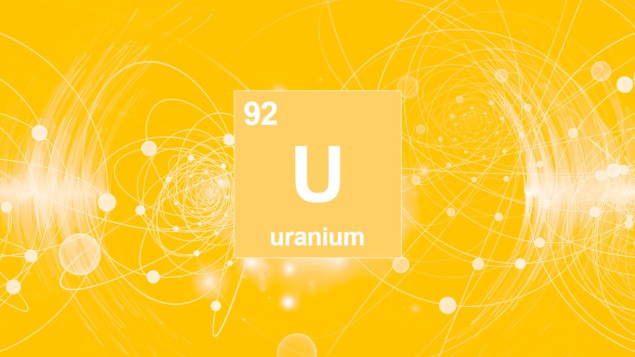Which is your favourite chemical element? To mark the International Year of the Periodic Table, our science journalists will be arguing for their pick from the 118 known elements. In this instalment, Matin Durrani makes the case for uranium, which has had an enormous impact on physics and opened the door to nuclear power

Uranium. It’s big. Clocking in (mostly) with 92 protons and 146 neutrons, it’s the heaviest “primordial” element. That makes it the most massive element on Earth to have been created before our planet existed. Not that you’ll ever find it as a pure element, only inside other compounds. When refined, it’s a silvery-white metal.
But uranium’s not just physically large. It’s also had a massive influence on our understanding of physics. More so, I’d argue, than any other element.
Radioactivity and isotopes
Remember Henri Becquerel? In 1896 the French physicist placed a uranium salt on top of a photographic plate with a copper sheet shaped in the form of a cross in between. Despite wrapping the plate in thick black paper and storing it in a drawer to keep sunlight at bay, the plate – when developed – revealed an image of the cross. Becquerel had discovered radioactivity.
So thanks to uranium, we know that atoms aren’t always unchanging, constant objects. Uranium’s radioactive decay therefore brought to physics the notion of intrinsically statistical events. You can’t precisely predict when any individual nucleus will decay – you can only analyse the probability based on the statistics of many nuclei. And as we know, statistics plays an essential part in understanding the weird quantum world.
Uranium’s second big physics claim to fame rests on work carried out in the early 1900s by Frederick Soddy and Ada Hitchins. Their experiments not only showed that uranium decays into radium, spitting out an alpha particle. It also revealed the existence of isotopes – the fact that one element can have more than one atomic mass. Each isotope of an element has the same number of protons, but different numbers of neutrons. So: think isotopes, thank uranium.
Splitting up
In uranium’s case, by far the most common isotope is uranium-238. But there’s also uranium-235, with 92 protons and 143 neutrons, making up 0.7% of all uranium. As Otto Hahn, Lise Meitner and Fritz Strassmann discovered in 1938, firing neutrons at uranium-235 splits it into barium and krypton nuclei, releasing further neutrons.
The discovery of nuclear fission was revolutionary, with Leó Szilárd later realizing it could be used to create a chain reaction. Nuclear bombs and nuclear power were only a step away.

An unelementary affair: 150 years of the periodic table
We now know that uranium-235 is the the only naturally occurring “fissile” isotope, which means it can be split with low-energy, thermal neutrons. As opposed to “fissionable” nuclei, such as uranium-238, which can be split only with high-energy neutrons. Depleted uranium, which has only about 0.3% of uranium-235, meanwhile, is used as counterweights in aircraft, radiation shielding in medical radiation therapy, and containers for transporting radioactive materials.
Three of the best
So there we have it. Uranium is the top element in physics for three clear reasons: it led us to discover radioactivity, isotopes and nuclear fission. And while you might not like nuclear power or nuclear weapons, they have – for better or worse – revealed the huge influence that uranium has had on the fate and fortunes of the world.
What’s your favourite element? Contact us at pwld@ioppublishing.org with your pick – and the reason why – or via Twitter using the hashtag #battleofelements.



